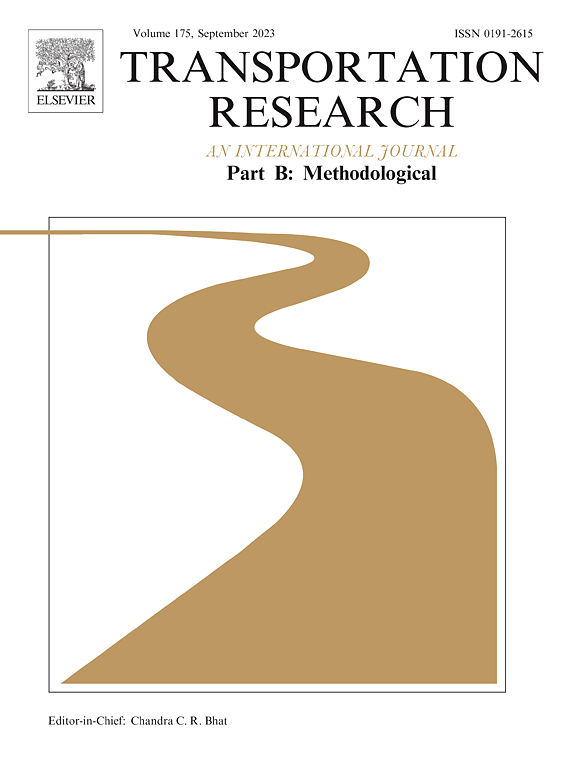自动驾驶汽车跟随车辆的非线性振荡响应:考虑交通状态和控制输入限制的理论分析
IF 6.3
1区 工程技术
Q1 ECONOMICS
引用次数: 0
摘要
本文基于描述函数(DF)理论和增量输入DF理论,在考虑交通状态和控制输入限制的情况下,从理论上分析了自动驾驶汽车(AVs)跟车(CF)在交通振荡中的非线性振荡响应。虽然主流方法在很大程度上忽略了这些限制(即加/减速和速度饱和),并将重点放在线性串稳定性分析上,但该框架为从理论上分析由这些限制施加的非线性的自动驾驶系统的频率响应奠定了基础。为此,将CF对的轨迹分解为标称轨迹和振荡轨迹,然后在振荡轨迹坐标内对被控AV系统进行重新定位。在此基础上,利用非线性饱和分量的一阶谐波输出来近似非线性饱和分量的频率响应,从而捕获相关的放大比和相移。考虑到AV控制系统的闭环特性,系统状态和控制输入相互影响,在回路内平衡放大比和相移以保证一致性。这个平衡过程可能会产生多个解决方案,因此增量输入DF进一步应用于确定合理的解决方案。通过Simulink的估计验证了该方法的有效性,并与现有方法进行了进一步的比较。结果证实了我们的框架与Simulink结果的一致性,并显示出与主流方法相比,其分析精度更高。此外,该框架在弦的稳定性分析中被证明是有价值的,特别是当传统的线性方法提供误导性的见解时。本文章由计算机程序翻译,如有差异,请以英文原文为准。
Nonlinear oscillatory response of automated vehicle car-following: Theoretical analysis with traffic state and control input limits
This paper presents a framework grounded in the theory of describing function (DF) and incremental-input DF to theoretically analyze the nonlinear oscillatory response of automated vehicles (AVs) car-following (CF) amidst traffic oscillations, considering the limits of traffic state and control input. While prevailing approaches largely ignore these limits (i.e., saturation of acceleration/deceleration and speed) and focus on linear string stability analysis, this framework establishes a basis for theoretically analyzing the frequency response of AV systems with nonlinearities imposed by these limits. To this end, trajectories of CF pairs are decomposed into nominal and oscillatory trajectories, subsequently, the controlled AV system is repositioned within the oscillatory trajectory coordinates. Built on this base, DFs are employed to approximate the frequency responses of nonlinear saturation components by using their first harmonic output, thereby capturing the associated amplification ratio and phase shift. Considering the closed-loop nature of AV control systems, where system states and control input mutually influence each other, amplification ratios and phase shifts are balanced within the loop to ensure consistency. This balancing process may render multiple solutions, hence the incremental-input DF is further applied to identify the reasonable ones. The proposed method is validated by estimations from Simulink, and further comparisons with prevailing methods are conducted. Results confirm the alignment of our framework with Simulink results and exhibit its superior accuracy in analysis compared to the prevailing methods. Furthermore, the framework proves valuable in string stability analysis, especially when conventional linear methods offer misleading insights.
求助全文
通过发布文献求助,成功后即可免费获取论文全文。
去求助
来源期刊
CiteScore
12.40
自引率
8.80%
发文量
143
审稿时长
14.1 weeks
期刊介绍:
Transportation Research: Part B publishes papers on all methodological aspects of the subject, particularly those that require mathematical analysis. The general theme of the journal is the development and solution of problems that are adequately motivated to deal with important aspects of the design and/or analysis of transportation systems. Areas covered include: traffic flow; design and analysis of transportation networks; control and scheduling; optimization; queuing theory; logistics; supply chains; development and application of statistical, econometric and mathematical models to address transportation problems; cost models; pricing and/or investment; traveler or shipper behavior; cost-benefit methodologies.

 求助内容:
求助内容: 应助结果提醒方式:
应助结果提醒方式:


